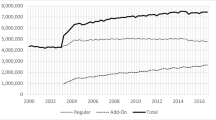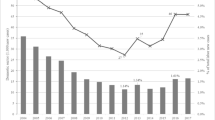Abstract
Bureaucrats in the government sector have a double role since they are both suppliers and demanders of public employment; they are publicly employed (supply labor) and they have an important say in deciding the size of the municipal employment (demand labor). In this paper we present and estimate a theoretical model that focuses on this double role of bureaucrats. The predictions from the theoretical model are supported by our empirical results: The estimates, based on data from Swedish municipalities 1990–2002, show that wages have smaller effects on the demand for bureaucrats than on the demand for other types of public employees. Actually, wages have no significant effect on the number of bureaucrats the municipality employs.
Similar content being viewed by others
References
Anderson, T., & Hsiao, C. (1981). The estimation of dynamic models with error components. Journal of the American Statistical Association, 76, 598–606.
Bailey, S. J., & Connolly, S. (1998). The flypaper effect: Identifying areas for further research. Public Choice, 95, 335–361.
Bergström, P., Dahlberg, M., & Mörk, E. (2004). The effects of grants and wages on municipal labour demand. Labour Economics, 11, 315–334.
Borge, L.-E., & Rattsø, J. (1993). Dynamic responses to changing demand: A model of the reallocation process in small and large municipalities in Norway. Applied Economics, 25, 589–598.
Breton, A., & Wintrobe, R. (1975). The equilibrium size of a budget maximizing bureau: A note on niskanen's theory of bureaucracy. Journal of Political Economy, 83, 195–207.
Courant, P. N., Gramlich, E. M., & Rubinfeld, D. L. (1979). Public employee market power and the level of government spending. American Economic Review, 69, 806–817.
Dahlberg, M., & Johansson, E. (1998). The revenues-expenditures nexus: Panel data evidence from Swedish municipalities. Applied Economics, 30, 1379–1386.
Dahlberg, M., & Johansson, E. (2000). An examination of the dynamic behavior of local governments using GMM bootstrapping methods. Journal of Applied Econometrics, 15, 401–416.
Dahlberg, M., & Lindström, T. (1998). Are local governments governed by forward looking decision makers? An investigation of spending patterns in Swedish municipalities. Journal of Urban Economics, 44, 254–271.
Dixit, A., & Londregan, J. (1996). The determinants of success of special interests in redistributive politics. Journal of Politics, 58, 1132–1155.
Eavey, C. L., & Miller, G. J. (1984). Bureaucratic agenda control: Imposition of bargaining?. The American Political Science Review, 78, 719–733.
Gregory, R. G., & Borland, J. (1999). Recent development in public sector labor markets, Chapter 53 in O. Ashenfelter, & D. Card (Eds.), Handbook of Labor Economics, Vol 3, Elsevier, North Holland.
Kalseth, J., & Rattsø, J. (1998). Political control of administrative spending: The case of local governments in Norway. Economics and Politics, 10, 181–201.
Miller, G. J. (1977). Bureaucratic compliance as a game on the unit square. Public Choice, 19, 37–51.
Mueller, D. C. (1989). Public Choice II, Cambridge University Press, Cambridge.
Nickell, S. (1981). Biases in dynamic models with fixed effects. Econometrica, 49, 1417–1426.
Niskanen, W. (1971). Bureaucracy and Representative Government, Aldine-Atherton, Chicago.
OECD. (2002). Highlights of public sector pay and employment trends: 2002 Update.
Peters, G. B. (1995). The Politics of Bureaucracy, 4th Edition, White Plains, New York.
Romer, T., & Rosenthal, H. (1978). Political resource allocation, controlled agendas, and the status quo. Public Chocie, 33, 27–43.
Romer, T., & Rosenthal, H. (1979). Bureaucrats versus voters: On the political economy of resource allocation by direct democracy. The Quarterly Journal of Economics, 93, 563–587.
Romer, T., & Rosenthal, H. (1982). Median voters or budget maximizers: Evidence from school expenditure referenda. Economic Inquiry, 20, 556–578.
Author information
Authors and Affiliations
Corresponding author
Rights and permissions
About this article
Cite this article
Dahlberg, M., Mörk, E. Public employment and the double role of bureaucrats. Public Choice 126, 387–404 (2006). https://doi.org/10.1007/s11127-006-2457-8
Accepted:
Issue Date:
DOI: https://doi.org/10.1007/s11127-006-2457-8




